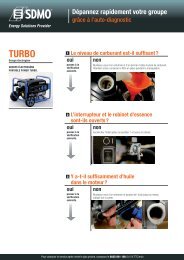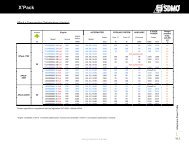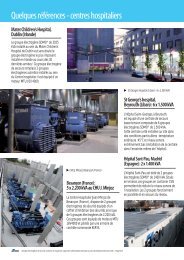Documentation - SDMO
Documentation - SDMO
Documentation - SDMO
Create successful ePaper yourself
Turn your PDF publications into a flip-book with our unique Google optimized e-Paper software.
3 essential steps to<br />
choosing the right water pump.<br />
AQUALINE TM pumps are designed for professional use to meet the particular requirements of each worksite, from transferring clean water to more exacting<br />
requirements.<br />
All <strong>SDMO</strong> ® pumps are self-priming: there is an anti-return valve to fill the intake system by pumping the air through.<br />
NB: the pump must be primed before it is started.<br />
1 Assess the nature of the water 3 Determine the flow<br />
or fluid to be pumped<br />
to choose the right output<br />
Since all liquids needing pumping do not share the same characteristics,<br />
<strong>SDMO</strong> ® water pumps are designed for multiple purposes depending on:<br />
Water quality<br />
Clean/nearly clean water or dirty water<br />
The AQUALINE TM INTENS range has 2 models, depending on the quality of<br />
the water to be pumped.<br />
- The ST model, specially designed for clear water, is recommended for<br />
applications such as pisciculture, pumping out swimming pools, etc.<br />
- The TR model is specially designed for pumping dirty water, in particular<br />
muddy trenches, excavations, sediment, etc.<br />
The flow corresponds to the maximum quantity of water that can be extracted<br />
at a given height. It is determined by checking the height of elevation in<br />
metres on the curve. The flow in L/min may then be deduced. The height of<br />
elevation determines the available pressure.<br />
This is divided by 10 to obtain the pressure in bar. If this pressure is not<br />
enough, a more powerful model should be selected.<br />
The flow and the discharge height are the main criteria used in selecting<br />
your water pump.<br />
TECHNICAL CHARACTERISTICS<br />
Model<br />
AQUALINE TM INTENS<br />
AQUALINE TM SPECIALIST<br />
ST 2.36 H ST 3.60 H TR 2.36 H TR 3.60 H HP 2.26 H XC 2.34 H XT 3.78 H TRASH 4<br />
Special fluids, very dirty water and high pressure<br />
There are 3 models of AQUALINE TM SPECIALIST for specific applications.<br />
- The HP 2.26 H is designed for effectively cleaning floors, terraces, agricultural<br />
or worksite plant. It is also invaluable for first line fire-fighting.<br />
- The XC 2.34 H is recommended for agricultural use, for pumping liquid<br />
manure and for handling salt water.<br />
- The XT 3.78 H and TRASH 4 are designed for pumping very dirty water,<br />
for extreme, intensive use, and can handle solid particles from 20 to 30 mm.<br />
Helix<br />
Graphite<br />
cast iron<br />
Graphite<br />
cast iron<br />
Impeller Cast iron Cast iron<br />
Mechanical<br />
seal<br />
Ease of<br />
removal<br />
Ceramic<br />
carbon<br />
Ceramic<br />
carbon<br />
Graphite<br />
cast iron<br />
Graphite<br />
cast iron<br />
Silicon<br />
carbide<br />
Graphite<br />
cast iron<br />
Graphite<br />
cast iron<br />
Silicon<br />
carbide<br />
Graphite<br />
cast iron<br />
Graphite<br />
cast iron<br />
Ceramic<br />
carbon<br />
PET*<br />
PET*<br />
Ceramic<br />
carbon<br />
Graphite<br />
cast iron<br />
Graphite<br />
cast iron<br />
Silicon<br />
carbide<br />
Graphite<br />
cast iron<br />
Graphite<br />
cast iron<br />
Silicon<br />
carbide<br />
• • •• •• • • ••• •••<br />
• Tool required •• Tool supplied ••• No tool required * PolyEthylene Terephtalate<br />
Silicon carbide: higher abrasion resistance, lasts longer, low maintenance.<br />
Graphite cast iron: harder, more resistant, too particulate abrasion when taking in water<br />
The flow and pressure equired depending on the head losses.<br />
2 Calculate the height<br />
of the elevation required<br />
The elevation is more or less important depending on the configuration<br />
of the installation or the application (pumping out, sprinkling, irrigation,<br />
draining, washing). It is calculated from:<br />
Typical application<br />
Performance curve<br />
The suction height<br />
This is the difference in height between the level of the water to be<br />
pumped and the axle of the pump. The laws of physics dictate that this<br />
cannot exceed 8m.<br />
The discharge height<br />
This is the difference in height between the axle of the pump and the<br />
highest point of the network.<br />
The head loss<br />
This is the resistance encountered by the water in the pipes. It is calculated<br />
according to the length, diameter and quality of the pipes, their shapes<br />
and the number of accessories (for general cases, we take 20%).<br />
Discharge<br />
height<br />
Suction<br />
height<br />
12 m<br />
3 m<br />
Water<br />
pump<br />
Head = 3m + 12m = 15m<br />
Height of elevation in m<br />
Flow in L/min.<br />
Height of elevation = suction height<br />
+ height of lift + head loss<br />
27








